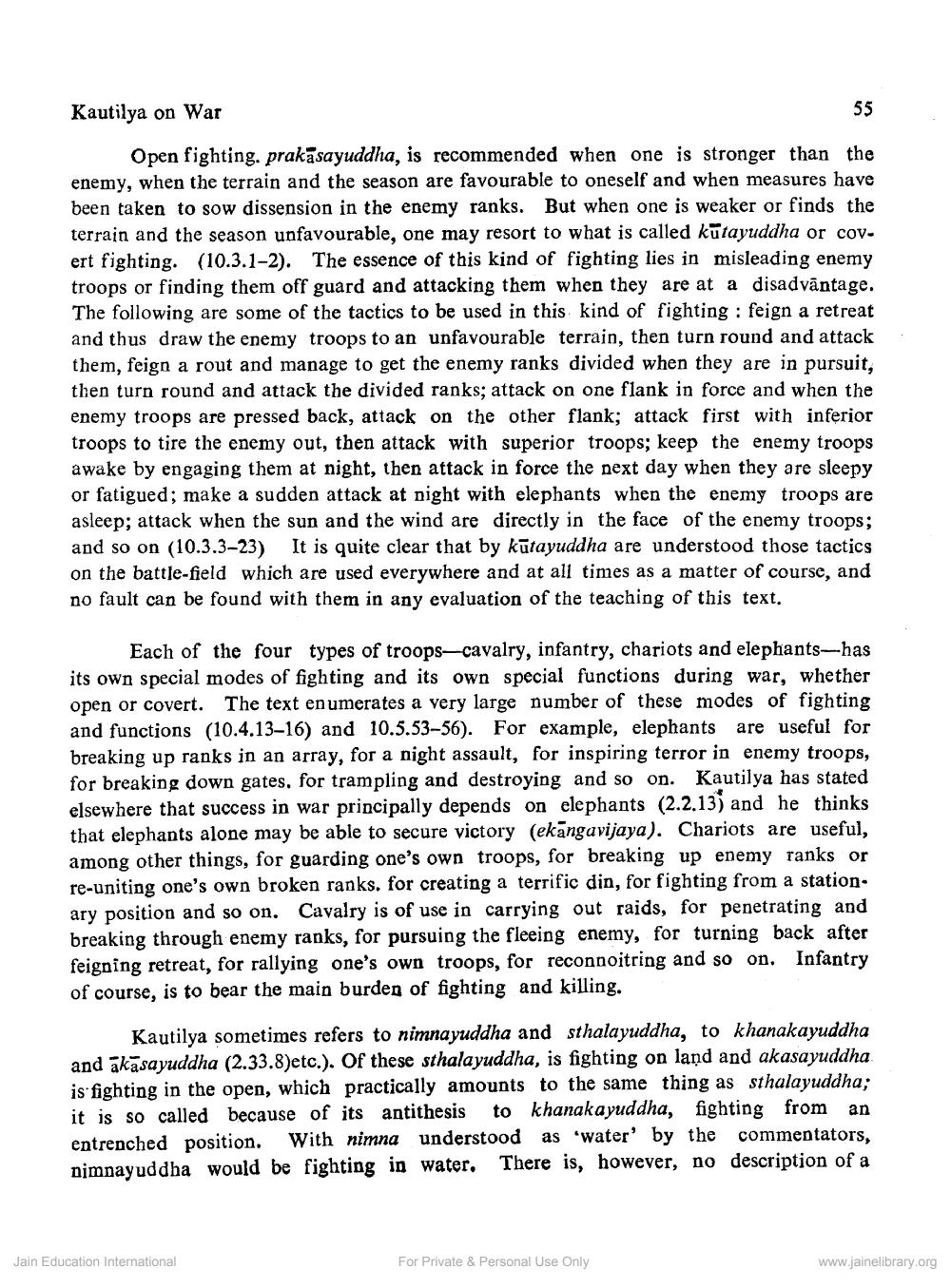Book Title: Kautilya on war Author(s): R P Kangle Publisher: Z_Jinvijay_Muni_Abhinandan_Granth_012033.pdf View full book textPage 6
________________ Kautilya on War Open fighting, prakāsayuddha, is recommended when one is stronger than the enemy, when the terrain and the season are favourable to oneself and when measures have been taken to sow dissension in the enemy ranks. But when one is weaker or finds the terrain and the season unfavourable, one may resort to what is called kūtayuddha or cov. ert fighting. (10.3.1-2). The essence of this kind of fighting lies in misleading enemy troops or finding them off guard and attacking them when they are at a disadvāntage. The following are some of the tactics to be used in this kind of fighting : feign a retreat and thus draw the enemy troops to an unfavourable terrain, then turn round and attack them, feign a rout and manage to get the enemy ranks divided when they are in pursuit, then turn round and attack the divided ranks; attack on one flank in force and when the enemy troops are pressed back, attack on the other flank; attack first with inferior troops to tire the enemy out, then attack with superior troops; keep the enemy troops awake by engaging them at night, then attack in force the next day when they are sleepy or fatigued; make a sudden attack at night with elephants when the enemy troops are asleep; attack when the sun and the wind are directly in the face of the enemy troops; and so on (10.3.3-23) It is quite clear that by kūtayuddha are understood those tactics on the battle-field which are used everywhere and at all times as a matter of course, and no fault can be found with them in any evaluation of the teaching of this text. Each of the four types of troops-cavalry, infantry, chariots and elephants-has its own special modes of fighting and its own special functions during war, whether open or covert. The text enumerates a very large number of these modes of fighting and functions (10.4.13–16) and 10.5.53-56). For example, elephants are useful for breaking up ranks in an array, for a night assault, for inspiring terror in enemy troops, for breaking down gates, for trampling and destroying and so on. Kautilya has stated elsewhere that success in war principally depends on elephants (2.2.13) and he thinks that elephants alone may be able to secure victory (ekāngavijaya). Chariots are useful, among other things, for guarding one's own troops, for breaking up enemy ranks or re-uniting one's own broken ranks. for creating a terrific din, for fighting from a station. ary position and so on. Cavalry is of use in carrying out raids, for penetrating and breaking through enemy ranks, for pursuing the fleeing enemy, for turning back after feigning retreat, for rallying one's own troops, for reconnoitring and so on, Infantry of course, is to bear the main burden of fighting and killing. Kautilya sometimes refers to nimnayuddha and sthalayuddha, to khanakayuddha and akasayuddha (2.33.8)etc.). Of these sthalayuddha, is fighting on land and akasayuddha is fighting in the open, which practically amounts to the same thing as sthalayuddha; it is so called because of its antithesis to khanakayuddha, fighting from an entrenched position. With nimna understood as 'water' by the commentators, nimpayuddha would be fighting in water. There is, however, no description of a Jain Education International For Private & Personal Use Only www.jainelibrary.orgPage Navigation
1 ... 4 5 6 7 8
